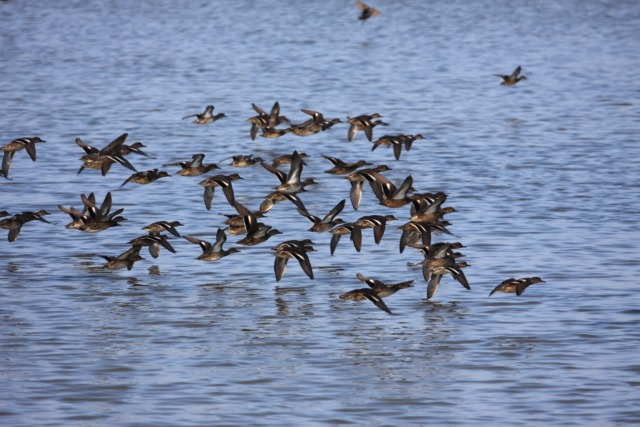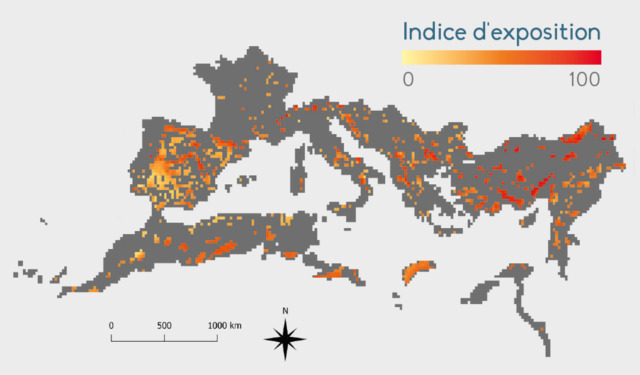This study highlights the high exposure of Key Biodiversity Areas[1] [1] to future climate and land use changes in the Mediterranean region. It underlines the urgency of implementing protection measures on these sites to mitigate these changes, particularly in the Maghreb and the Near East where Key Biodiversity Areas are both poorly protected and highly exposed. This work was coordinated by the Tour du Valat Research Institute for the Conservation of Mediterranean Wetlands and the Ecology and Conservation Sciences Centre (CESCO – National Natural History Museum, CNRS, Sorbonne University). This study was recently published in Conservation Science and Practice.
To find out more, read or download the press release below.
Press release
Arles, 11 October 2022
A team of scientists coordinated by the Tour du Valat Research Institute for the Conservation of Mediterranean Wetlands and the Centre for Ecology and Conservation Sciences (CESCO – National Natural History Museum, CNRS, Sorbonne University) has published new results on future climate and land use changes that threaten “Key Biodiversity Areas”[1] [1] in the Mediterranean Basin. These results show that the network of Key Biodiversity Areas is both insufficiently protected and highly threatened by human activities, and therefore highlight the importance of implementing strong protection measures. This study was published on October 10 in Conservation Science and Practice.
A target to protect 30% of the world’s total area by 2030
Human activities are at the origin of climate change and the degradation of natural environments, which is leading to the sixth mass extinction crisis. The creation of protected areas is one of the most effective levers for reducing their impact on biodiversity. The target to protect 30% of the world’s land and sea area by 2030, currently being negotiated by the United Nations, represents a tremendous opportunity to better conserve biodiversity. However, the creation of protected areas has often focused on areas that are not very accessible and of little economic interest, rather than on the most important sites for biodiversity, such as Key Biodiversity Areas, which are internationally recognised as being of major importance for biodiversity conservation. Moreover, the choice of the areas to be protected has so far taken little account of the future impacts of human activities and more specifically of future climate and land use changes (agriculture, urbanisation), due to the lack of knowledge, data, and decision support tools.

In this seminal study, researchers assessed future climate and land use changes in Key Biodiversity Areas to identify the sites most at risk and deserving priority protection as needed. This prioritisation of sites at risk was based on climate and land use projections for the end of the 21st century according to the most recent Intergovernmental Panel on Climate Change (IPCC) scenarios. The authors focused on the Mediterranean region (29 countries), a global biodiversity hotspot, but also one of the regions most threatened by human pressures.
Key areas for biodiversity conservation under severe threat by the end of the century
The research team found that Key Biodiversity Areas are more threatened by future climate and land use changes than sites with lesser biodiversity concerns in the Mediterranean, regardless of the future climate scenario. On the other hand, the regions that will be strongly impacted by climate change are generally not the same as those threatened by future land-use changes, hence the interest in taking account of these two criteria when designating new protected areas. Finally, not only are the Key Biodiversity Areas insufficiently protected in the Mediterranean, but the most threatened sites are in countries where their protection is the weakest. For example, Turkey is home to many of the most threatened unprotected biodiversity hotspots.

The urgent need to create new protected areas in the southern and eastern Mediterranean

These results underline the urgency of extending the Mediterranean network of protected areas by targeting the most highly threatened unprotected Key Biodiversity Areas to better anticipate the future impact of human activities on biodiversity. These protection measures should be focused on the countries of the Maghreb and the Near East, whose sites of importance for biodiversity are both the most threatened and the least protected, while ensuring that the human and financial resources needed to implement this protection are mobilised. Finally, while this study highlights the need to reduce our greenhouse gas emissions, it also reminds us of the importance of taking into account and limiting other human pressures such as the loss and degradation of natural environments, in order to limit our impact on biodiversity as much as possible.
[1] [2] Key Biodiversity Areas are a global network of high biodiversity value sites created by the IUCN
Reference : Verniest, F., Galewski, T., Julliard, R., Guelmami, A., & Le Viol, I. (2022). Coupling future climate and land-use projections reveals where to strengthen the protection of Mediterranean Key Biodiversity Areas. Conservation Science and Practice. https://doi.org/10.1111/csp2.12807 [3]
Press contact: Coralie HERMELOUP : +33 (0)4 90 97 28 70 [email protected] [4] / [email protected] [5]